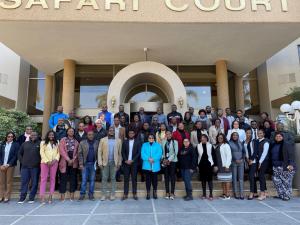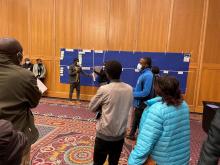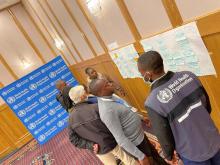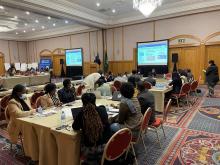Namibia conducts After Action Review for the 2017-2022 Hepatitis E Outbreak Response
Namibia declared the end of the Hepatitis E Virus (HEV) outbreak on 02 March 2022 after battling with the outbreak for almost 4 years since December 2017. What started as a centralized outbreak in the informal settlements of Havana and Goreagab in Windhoek, the capital city of Namibia, soon spread to 13 of the 14 regions in Namibia which had similar settings such as limited access to safe water, sanitation and hygiene. The entire outbreak recorded a total of 2,124 (26.2%) laboratory-confirmed cases, 4,738 (58.6%) epidemiologically linked cases, 1,230 (15.2%) suspected cases and 66 deaths.
Mrs. Wilka Nakulaya from Oluvango, Namulenge constituency in Omusati Region was one of 8,092 people who were diagnosed with HEV in 2020. She visited the Onawa clinic after feeling ill, where she was diagnosed with HEV at the point of care, and treatment was initiated immediately. Although it was difficult for her to accept the diagnosis, Wilka adhered to the advice from the health worker on taking her medication, practicing safe hygiene and changing her diet which aided her quick recovering.
Wilka’s story is one of many Namibians that were impacted by the government’s response to control the outbreak, where a reduction in cases and deaths was observed due to measures implemented by the government and partners. In addition to improved quality of care and rapid diagnosis, the HEV incident management also addressed Water, Sanitation and Hygiene (WASH), Infection Prevention and Control (IPC), and Risk Communication and Community Engagement (RCCE) as core elements of preparedness and response to the outbreak.
In order to document all these activities and also evaluate Namibia’s preparedness and response capacities to the HEV outbreak, the Ministry of Health and Social Services (MoHSS), with support from the World Health Organization (WHO) and other partners, convened an After Action Review (AAR) on 12-15 July 2022 at Safari Court Hotel, Windhoek, Namibia.
Through the AAR methodology, the 60 participants were able to conduct a qualitative review of actions taken to respond to HEV outbreak as a means of identifying gaps, lessons and best practices. The AAR was a necessary step to bring all partners together who contributed to the success of the government response to end the HEV outbreak. An AAR is one of 4 International Health Regulations (IHR 2005) Monitoring and Evaluation framework components and is recommended to be conducted within 3 months after the end of a public health response. An AAR is also part of the preparedness and response cycle.
The AAR participants were drawn from MoHSS national level directorates, regional level, districts, and health facilities. The other participants were from health partners including The World Health Organization (WHO), United Nations International Children's Emergency Fund (UNICEF) Namibia, Namibia Red Cross Society, Namibia Institute of Pathology, City of Windhoek, Development Workshop Namibia, University of Namibia, Namibia Field Epidemiology and Laboratory Programme and others.
During the AAR workshop, participants were divided into 5 groups representing the 5 response areas of the HEV response namely; coordination, surveillance, case management and IPC, RCCE and WASH. The workshop involved the participants recalling/ documenting the preparedness and response activities that were in place before and during the outbreak through the following steps: Step 1: What was in place before the response? Step 2: What happened during the response? Step 3: What went well? What went less well? Why? Step 4: What can we do to improve for next time? Step 5: The Way Forward. The review ended with the participants developing a comprehensive action plan for implementation of corrective actions to enhance preparedness and improve future response to Hepatitis E and other emergencies. The action plan highlighted the prioritized activities to institutionalize the best practices and address the challenges, a timeline for implementation of actions and a follow up mechanism.
During the AAR, the Deputy Executive Director, Ms. Petronella Masabane, delivered the key note address on behalf of MoHSS. She stated that “it is important to learn from past experiences, and make actionable recommendations so that we build on and sustain the strong areas, and change what did not work so well. And for us as a country, to build the needed capacities to prevent, detect and respond not only to future possible HEV outbreaks, but to all other public health events”. She further emphasized the need to build a resilient public health system that can withstand any public health threat.
The WHO Representative for Namibia, Dr Charles Sagoe-Moses, underlined the importance of ensuring that the AAR participants develop achievable corrective actions and come up with a mechanism to follow up and ensure that the actions are implemented. He emphasized on the need for the government and partners to always include and engage the affected communities during outbreak response and recovery activities.
Finally, it is critical to assess actions taken during a public health response in order to capitalize on best practices, identify actions for improvement, and promote individual and collective learning.
The WHO Namibia acknowledges the timely technical and financial support provided by the WHO Regional Office for Africa in Brazzaville, Republic of the Congo and WHO Headquarters Geneva, Switzerland, in conducting the AAR.
Tel: +264 (0) 61 255 121
Email: kaunatjikec [at] who.int (kaunatjikec[at]who[dot]int)
Emergency Preparedness and Response/Epidemiology Officer
Tel: +264-61-255121/191
Fax: +264-61-2046202
E-mail: deweer [at] who.int (deweer[at]who[dot]int)






